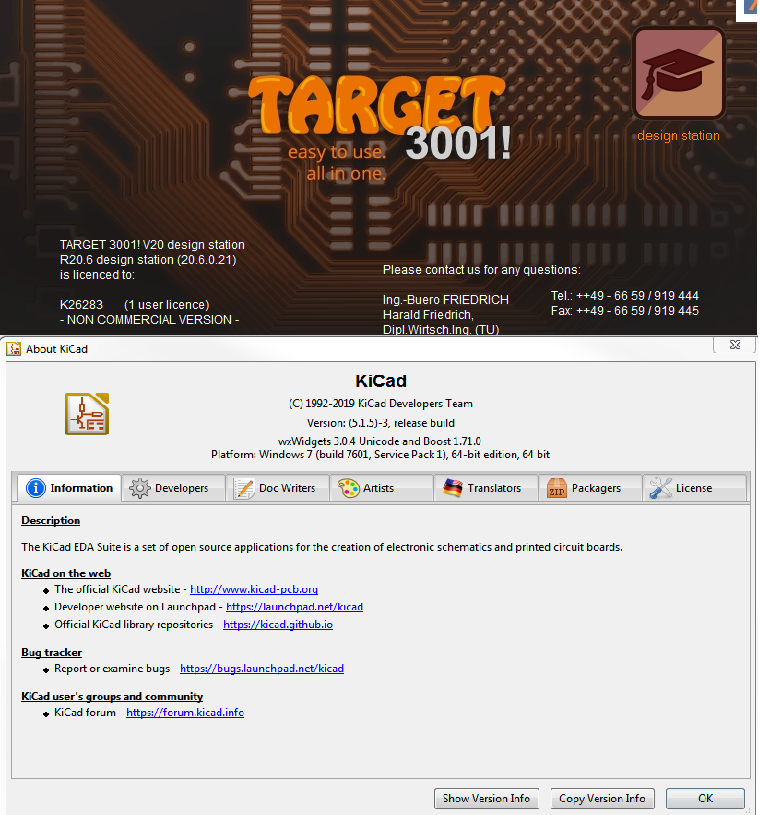- Craig Andrews
- Category Uncategorized
I have been asked a number of times if I can recommend an EDA package for other hobbyist that want to get into the PCB game. Obviously, there is not a right answer and even after using Schematic Capture and PCB layout programs for 40 years, I do not know which package I like best– but I can tell you the two that I use on a regular basis are Target 3001! and KiCAD. Both have their advantages and there is a little bit of history on how I got here. The short version is that I wanted something for personal use so a full commercial version was immediately off the table but the last time I had tried KiCAD it was really, really bad. Since Target offered a very useful reverse engineering tool, so at the time I didn’t even re-consider KiCAD and purchased a non-commercial version of Target 3001!. Since then, I have given KiCAD another look and am impressed by their progress in the last several years and KiCAD is now a formidable program.
I have no interest in doing a feature-by-feature comparison, you can download both and see for yourself or use this thing called “google” and see what others have to say. But I can easily tell you why I choose one or the other when starting a new project. It pretty much comes down to this— I only really have two hobbies, one being vintage computers and it occupies a lot of my time time and I like having the right tool for the job. One need I frequently have is to reverse engineer and document old PCBs that do not have a schematic. Hands down, when I need to reverse engineer I turn to Target 3001! and that alone makes it worth the money I spent. The reverse engineering tools are superb and the PCB documentation battle is nearly won when you have the right tools. Since it is such a nice tool, sometime I will do a video on using Target for reverse engineering to a schematic.
In addition to the reverse engineering, I originally gravitated towards Target because of its 3D model generation and especially 3D integration of a component to its footprint to make absolutely sure you have the designed the footprint correctly. Of course KiCAD has caught up on this front and also has some great 3D tools.
Every time I switch back and forth between the two packages it takes time to ramp back up and I am constantly wishing that the one I am using had some of the features of the one I am not. Mostly simple things really, like Target’s one button CAM to a zip file and easy file naming for version control that are both missing in KiCAD. The highest praise for Target is the customer support and the feeling that if you find a problem in the program it will be addressed. On the flip side, KiCADs user forum is a great asset. Especially since its documentation is so far out of date that it is often a mental liability to have read it.
A major difference between the two, and always a conversation starter– or conversation ender– is Target uses old-school intimately tied component and footprint where KiCAD separates the component from the footprint and uses footprint assignment. Being “old” myself, I prefer old school one-component-one-footprint but there have been a few times while using KiCAD I think “hey, this actually makes sense”.
If you, like me, are only using Target for doing schematic capture and PCB layout, you are only using a portion of the extremely capable features. It has many other supporting utilities so its users are getting much more than EDA.
Bottom line, KiCAD is free even for commercial use, its user base and adoption is growing by leaps and bounds, and it has some superior features. But it is still a community based program and subject to those limitations and culture. Target is a commercial, for profit program, stable, and historically has had a better feature set than KiCAD.
So based on where the two programs were a few years ago? Easy, the winner is Target 3001!. Based on where they are now? I am really glad that I have access to both and am considering moving up to a commercial version of Target because (even though I am creating community based projects) sometimes I am just not sure where the threshold is for “commercial”. Based on where they will be in a few years? Yea, I am sure the guys at Target, OrCAD, Eagle, Altium and the others must be asking themselves that every single day.

